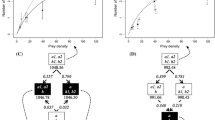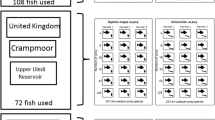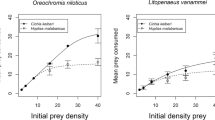Abstract
Biological invasions continue to exert pressure on ecosystems worldwide and we thus require methods that can help understand and predict the impacts of invasive species, on both native species and previously established invaders. Comparing laboratory derived functional responses among invasive and native predators has emerged as one such method, providing a robust proxy for field impacts. We used this method to examine the likely impacts of the Ponto–Caspian amphipod Dikerogammarus haemobaphes, known as the “demon shrimp”, a little investigated invader in European freshwaters that has recently established in the British Isles. We compared the functional responses on two prey species of D. haemobaphes with two other amphipod species: Dikerogammarus villosus, a congeneric invasive with well-documented impacts on macro-invertebrate communities and a native amphipod, Gammarus pulex. Prey species were native Chironomus sp. and the invasive Chelicorophium curvispinum, a tube-building amphipod also originating from the Ponto–Caspian region. D. villosus showed higher Type II functional responses towards both prey species than did D. haemobaphes and G. pulex, with the latter two predators exhibiting similar impacts on the native prey. However, D. haemobaphes had higher functional responses towards the invasive C. curvispinum than did G. pulex, both when prey individuals were tubeless and resident in their protective mud tubes. Thus, we demonstrate that functionally equivalent invasive congeners can show significantly different impacts on prey, regardless of shared evolutionary history. We also show that some predatory invaders can have impacts on native prey equivalent to native predator impacts, but that they can also exert significant impacts on previously introduced prey. We discuss the importance of invasion history and prey identity when attempting to understand and predict the impacts of new invaders.



Similar content being viewed by others
References
Alexander ME, Dick JTA, Haddaway NR, Farnsworth KD (2012) Functional responses of the intertidal amphipod Echinogammarus marinus: effects of prey supply, model selection and habitat complexity. Mar Ecol Prog Ser 468:191–202
Alexander ME, Dick JTA, Weyl OLF, Robinson TB, David M, Robinson B, Richardson DM (2014) Existing and emerging high impact invasive species are characterized by higher functional responses than natives. Biol Lett 10:20130946. doi:10.1098/rsbl.2013.0946
Bacela K, Konopacka A, Grabowski M (2009) Reproductive biology of Dikerogammarus haemobaphes: an invasive gammarid (Crustacea: Amphipoda) colonizing running waters in Central Europe. Biol Invasions 11:2055–2066. doi:10.1007/s10530-009-9496-2
Bacela-Spychalska K, Van Der Velde G (2013) There is more than one “killer shrimp”: trophic positions and predatory abilities of invasive amphipods of Ponto–Caspian origin. Freshw Biol 58:730–741. doi:10.1111/fwb.12078
Bacela-Spychalska K, Rigaud T, Wattier RA (2014) A co-invasive microsporidian parasite that reduces the predatory behaviour of its host Dikerogammarus villosus (Crustacea, Amphipoda). Parasitology 141:254–258. doi:10.1017/S0031182013001510
Barrios-O’Neill D, Dick JTA, Emmerson MC, Ricciardi A, Macisaac HJ, Alexander ME, Bovy HC (2014) Fortune favours the bold: a higher predator reduces the impact of a native but not an invasive intermediate predator. J Anim Ecol 83:693–701. doi:10.1111/1365-2656.12155
Bij de Vaate A, Jazdzewski K, Ketelaars HAM, Gollasch S, Van der Velde G (2002) Geographical patterns in range extension of Ponto–Caspian macroinvertebrate species in Europe. Can J Fish Aquat Sci 59:1159–1174. doi:10.1139/F02-098
Boets P, Lock K, Messiaen M, Goethals PLM (2010) Combining data-driven methods and lab studies to analyse the ecology of Dikerogammarus villosus. Ecol Inform 5:133–139. doi:10.1016/j.ecoinf.2009.12.005
Bolker BM (2008) Ecological models in R. Princeton University Press, Princeton
Bolker BM, Gardner B, Maunder M et al (2013) Strategies for fitting nonlinear ecological models in R, AD Model Builder, and BUGS. Methods Ecol Evol 4:501–512. doi:10.1111/2041-210X.12044
Bollache L, Dick JTA, Farnsworth KD, Montgomery WI (2008) Comparison of the functional responses of invasive and native amphipods. Biol Lett 4:166–169. doi:10.1098/rsbl.2007.0554
Carlsson NO, Sarnelle O, Strayer DL (2009) Native predators and exotic prey—an acquired taste? Front Ecol Environ 7:525–532. doi:10.1890/080093
Casellato S, Visentin A, La Piana G (2007) The predatory impact of Dikerogammarus villosus on fish. In: Gherardi F (ed) Biological invaders in inland waters: profiles, distributions and threats. Springer, Dordrecht, pp 495–506
Catford JA, Jansson R, Nilsson C (2009) Reducing redundancy in invasion ecology by integrating hypotheses into a single theoretical framework. Divers Distrib 15:22–40. doi:10.1111/j.1472-4642.2008.00521.x
Cox JG, Lima SL (2006) Naiveté and an aquatic-terrestrial dichotomy in the effects of introduced predators. Trends Ecol Evol 21:674–680. doi:10.1016/j.tree.2006.07.011
Crawford GI (1935) Corophium curvispinum, G.O. Sars, var. devium, Wundsch in England. Nature 136:685–686
DAISIE European Invasive Alien Species Gateway (2013) http://www.europe-aliens.org/. Accessed 15 Dec 2013
Dick JTA, Platvoet D (2000) Invading predatory crustacean Dikerogammarus villosus eliminates both native and exotic species. Proc R Soc B 267:977–983. doi:10.1098/rspb.2000.1099
Dick JTA, Platvoet D, Kelly DW (2002) Predatory impact of the freshwater invader Dikerogammarus villosus (Crustacea: Amphipoda). Can J Fish Aquat Sci 59:1078–1084. doi:10.1139/F02-074
Dick JTA, Gallagher K, Avlijas S, Clarke HC, Lewis SE, Leung S, Minchin D, Caffrey J, Alexander ME, Maguire C, Harrod C, Reid N, Haddaway NR, Farnsworth KD, Penk M, Ricciardi A (2013) Ecological impacts of an invasive predator explained and predicted by comparative functional responses. Biol Invasions 15:837–846. doi:10.1007/s10530-012-0332-8
Dick JTA, Alexander ME, Jeschke JM, Ricciardi A, MacIsaac HJ, Robinson TB, Kumschick S, Weyl OLF, Dunn AM, Hatcher MJ, Paterson RA, Farnsworth KD, Richardson DM (2014) Advancing impact prediction and hypothesis testing in invasion ecology using a comparative functional response approach. Biol Invasions 16:735–753. doi:10.1007/s10530-013-0550-8
Dixon PM (2001) The bootstrap and the jackknife: describing the precision of ecological indices. In: Scheiner SM, Gurevitch J (eds) Design and analysis of ecological experiments, 2nd edn. Oxford University Press, Oxford, pp 267–288
Dobson M (2012) Identifying invasive freshwater shrimps and isopods. Freshwater Biological Association, Ambelside
Dodd JA, Dick JTA, Alexander ME, MacNeil C, Dunn AM, Aldridge DC (2014) Predicting the ecological impacts of a new freshwater invader: functional responses and prey selectivity of the “killer shrimp”, Dikerogammarus villosus, compared to the native Gammarus pulex. Freshw Biol 59:337–352. doi:10.1111/fwb.12268
Environment Agency (2012) Invasive shrimp: Dikerogammarus haemobaphes, Interim briefing note. http://www.nonnativespecies.org/alerts/index.cfm?id=3. Accessed on 15 Nov 2012
Global Biodiversity Information Facility (2013) www.gbif.org. Accessed 15 Dec 2013
Godard MJ, Davison PI, Copp GH, Stebbing PD (2012) Review of invasion pathways and provisional pathway management plan for non-native Ponto–Caspian species of potential invasion risk to Great Britain. CEFAS, Weymouth
Harris RR, Musko IB (1999) Oxygen consumption, hypoxia and tube-dwelling in the invasive amphipod Corophium curvispinum. J Crustacean Biol 19:224–234
Hershey AE (1987) Tubes and foraging behavior in larval Chironomidae: implications for predator avoidance. Oecologia 73:236–241
Holling CS (1959a) The components of predation as revealed by a study of small-mammal predation of the European Pine Sawfly. Can Entomol 91:293–320
Holling CS (1959b) Some characteristics of simple types of predation and parasitism. Can Entomol 91:385–398
Jeschke JM, Tollrian R (2000) Density-dependent effects of prey defences. Oecologia 123:391–396. doi:10.1007/s004420051026
Jeschke J, Gómez Aparicio L, Haider S, Heger T, Lortie C, Pyšek P, Strayer D (2012) Support for major hypotheses in invasion biology is uneven and declining. NeoBiota 14:1–20. doi:10.3897/neobiota.14.3435
Josens G, Vaate ABD, Usseglio-Polatera P, Cammaerts R, Chérot F, Grisez F, Verboonen P, Vanden Bossche J-P (2005) Native and exotic Amphipoda and other Peracarida in the River Meuse: new assemblages emerge from a fast changing fauna. Hydrobiologia 542:203–220. doi:10.1007/s10750-004-8930-9
Juliano SA (2001) Nonlinear curve fitting: predation and functional response curves. In: Scheiner SM, Gurvitch J (eds) Design and analysis of ecological experiments, 2nd edn. Oxford University Press, Oxford, pp 178–196
Kobak J, Kakareko T, Poznańska M, Żbikowski J (2009) Preferences of the Ponto–Caspian amphipod Dikerogammarus haemobaphes for living zebra mussels. J Zool 279:229–235. doi:10.1111/j.1469-7998.2009.00610.x
Kondoh M (2006) Contact experience, alien–native interactions, and their community consequences: a theoretical consideration on the role of adaptation in biological invasions. In: Cadotte MW, McMahon SM, Fukami T (eds) Conceptual ecology and invasion biology: reciprocal approaches to nature, 1st edn. Springer, Dordrecht, pp 225–242
Krisp H, Maier G (2005) Consumption of macroinvertebrates by invasive and native gammarids: a comparison. J Limnol 64:55–59
MacNeil C, Platvoet D (2005) The predatory impact of the freshwater invader Dikerogammarus villosus on native Gammarus pulex (Crustacea: Amphipoda): influences of differential microdistribution and food resources. J Zool 267:31. doi:10.1017/S0952836905007351
MacNeil C, Platvoet D, Dick JTA, Fielding N, Constable A, Hall N, Aldridge D, Renals T, Diamond M (2010) The Ponto–Caspian “killer shrimp”, Dikerogammarus villosus (Sowinsky, 1894), invades the British Isles. Aquat Invasions 5:441–445. doi:10.3391/ai.2010.5.4.15
MacNeil C, Boets P, Lock K, Goethals PL (2013a) Potential effects of the invasive ‘killer shrimp’ (Dikerogammarus villosus) on macroinvertebrate assemblages and biomonitoring indices. Freshw Biol 58:171–182. doi:10.1111/fwb.12048
MacNeil C, Dick JTA, Alexander ME, Dodd JA, Ricciardi A (2013b) Predators vs. alien: differential biotic resistance to an invasive species by two resident predators. NeoBiota 19:1–19. doi:10.3897/neobiota
Matern SA, Brown LR (2005) Invaders eating invaders: exploitation of novel alien prey by the alien shimofuri goby in the San Francisco Estuary, California. Biol Invasions 7:497–507
Mayer G, Maier G, Maas A, Waloszek D (2008) Mouthparts of the Ponto-Caspian invader Dikerogammarus villosus (Amphipoda:Pontogammaridae). J Crustac Biol 28:1–15. doi:10.1651/07-2867R.1
McGeoch MA, Spear D, Kleynhans EJ, Marais E (2012) Uncertainty in invasive alien species listing. Ecol Appl 22:959–971
Moon HP (1970) Corophium curvispinum (Amphipoda) recorded again in the British Isles. Nature 226:976
Müller JC, Schramm S, Seitz A (2002) Genetic and morphological differentiation of Dikerogammarus invaders and their invasion history in Central Europe. Freshw Biol 47:2039–2048
Murdoch WW (1973) The functional response of predators. J Appl Ecol 10:335–342
Murdoch WW, Oaten A (1975) Predation and population stability. Adv Ecol Res 9:1–131
Muskó IB (1990) Qualitative and quantitative relationships of Amphipoda (Crustacea) living on macrophytes in Lake Balaton (Hungary). Hydrobiologia 191:269–274
Noordhuis R, Schie J, Jaarsma N (2009) Colonization patterns and impacts of the invasive amphipods Chelicorophium curvispinum and Dikerogammarus villosus in the IJsselmeer area, The Netherlands. Biol Invasions 11:2067–2084. doi:10.1007/s10530-009-9487-3
Platvoet D, Dick JTA, Konijnendijk N, van der Velde G (2006) Feeding on micro-algae in the invasive Ponto-Caspian amphipod Dikerogammarus villosus (Sowinsky, 1894). Aquat Ecol 40:237–245. doi:10.1007/s10452-005-9028-9
Pritchard D (2014) Frair: functional response analysis in R. R package version 0.4
R Development Core Team (2013) R: A language and environment for statistical computing. R Foundation for Statistical Computing, Vienna, Austria. http://www.R-project.org/
Ricciardi A (2001) Facilitative interactions among aquatic invaders: is an “invasional meltdown” occurring in the Great Lakes? Can J Fish Aquat Sci 58:2513–2525. doi:10.1139/cjfas-58-12-2513
Ricciardi A, Hoopes MF, Marchetti MP, Lockwood JL (2013) Progress toward understanding the ecological impacts of nonnative species. Ecol Monogr 83:263–282
Rogers D (1972) Random search and insect population models. J Anim Ecol 41:369–383
Sala OE, Chapin FS, Armesto JJ et al (2000) Global biodiversity scenarios for the year 2100. Science 287:1770–1774
Saul W-C, Jeschke JM, Heger T (2013) The role of eco-evolutionary experience in invasion success. NeoBiota 17:57–74. doi:10.3897/neobiota.17.5208
Simberloff D (2013) Invasive species: what everyone needs to know. Oxford University Press, New York
Simberloff D, Martin J-L, Genovesi P, Maris V, Wardle DA, Aronson J, Courchamp F, Galil B, García-Berthou E, Pascal M, Pyšek P, Sousa R, Tabacchi E, Vilà M (2013) Impacts of biological invasions: what’s what and the way forward. Trends Ecol Evol 28:58–66. doi:10.1016/j.tree.2012.07.013
Sinclair ARE, Pech RP, Dickman CR, Hik D, Mahon P, Newsome AE (1998) Predicting effects of predation on conservation of endangered prey. Conserv Biol 12:564–575
Strayer DL (2010) Alien species in fresh waters: ecological effects, interactions with other stressors, and prospects for the future. Freshw Biol 55:152–174. doi:10.1111/j.1365-2427.2009.02380.x
Summers RB, Delong MD, Thorp JH (1997) Ontogenetic and temporal shifts in the diet of the amphipod Gammarus fasciatus in the Ohio River. Am Midl Nat 137:329–336
Twardochleb LA, Novak M, Moore JW (2012) Using the functional response of a consumer to predict biotic resistance to invasive prey. Ecol Appl 22:1162–1171
van den Brink FWB, van der Velde G, Bij de Vaate A (1991) Amphipod invasion on the Rhine. Nature 352:576
van den Brink FWB, van der Velde G, Bij de Vaate A (1993) Ecological aspects, explosive range extension and impact of a mass invader, Corophium curvispinumSars, 1895 (Crustacea: Amphipoda), in the Lower Rhine (The Netherlands). Oecologia 93:224–232
van der Velde G, Rajagopal S, Kelleher B, Muskó IB, Bij de Vaate A (2000) Ecological impact of crustacean invaders: general considerations and examples from the Rhine River. Crustac Issues 12:3–34
van der Velde G, Leuven RSEW, Platvoet D, Bacela K, Huijbregts MAJ, Hendriks HWM, Kruijt D (2009) Environmental and morphological factors influencing predatory behaviour by invasive non-indigenous gammaridean species. Biol Invasions 11:2043–2054. doi:10.1007/s10530-009-9500-x
van Kleunen M, Dawson W, Schlaepfer D, Jeschke JM, Fischer M (2010) Are invaders different? A conceptual framework of comparative approaches for assessing determinants of invasiveness. Ecol Lett 13:947–958. doi:10.1111/j.1461-0248.2010.01503.x
van Riel MC, van der Velde G, Bij de Vaate A (2006a) To conquer and persist: colonization and population development of the Ponto–Caspian amphipods Dikerogammarus villosus and Chelicorophium curvispinumon bare stone substrate in the main channel of the River Rhine. Arch Hydrobiol 166:23–39. doi:10.1127/0003-9136/2006/0166-0023
van Riel MC, van der Velde G, Rajagopal S, Marguillier S, Dehairs F, Bij de Vaate A (2006b) Trophic relationships in the Rhine food web during invasion and after establishment of the Ponto–Caspian invader Dikerogammarus villosus. Hydrobiologia 565:39–58. doi:10.1007/s10750-005-1904-8
Vilà M, Basnou C, Pyšek P, Josefsson M, Genovesi P, Gollasch S, Nentwig W, Olenin S, Roques A, Roy D, Hulme PE (2010) How well do we understand the impacts of alien species on ecosystem services? A pan-European, cross-taxa assessment. Front Ecol Environ 8:135–144. doi:10.1890/080083
Wattier RA, Haine ER, Beguet J, Martin G, Bollache L, Muskó IB, Platvoet D, Rigaud T (2007) No genetic bottleneck or associated microparasite loss in invasive populations of a freshwater amphipod. Oikos 116:1941–1953. doi:10.1111/j.2007.0030-1299.15921.x
Acknowledgments
We would like to thank the anonymous reviewers for their valuable comments, and Mandy Bunke for assistance in field sampling. This study was completed as part of a PhD funded by Queen’s University Belfast and Controlling Invasives, Restoring Biodiversity (CIRB), which is funded by the European Union’s INTERREG IVA Programme and by the Department of Environment, Northern Ireland (DOENI). JD acknowledges the support of NERC during the study.
Author information
Authors and Affiliations
Corresponding author
Rights and permissions
About this article
Cite this article
Bovy, H.C., Barrios-O’Neill, D., Emmerson, M.C. et al. Predicting the predatory impacts of the “demon shrimp” Dikerogammarus haemobaphes, on native and previously introduced species. Biol Invasions 17, 597–607 (2015). https://doi.org/10.1007/s10530-014-0751-9
Received:
Accepted:
Published:
Issue Date:
DOI: https://doi.org/10.1007/s10530-014-0751-9




